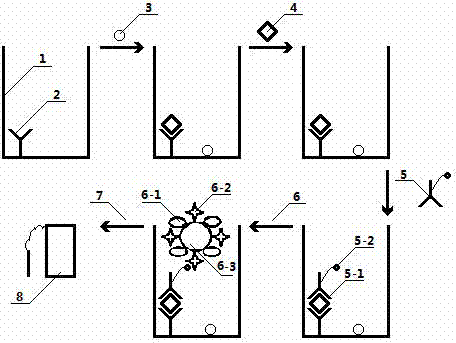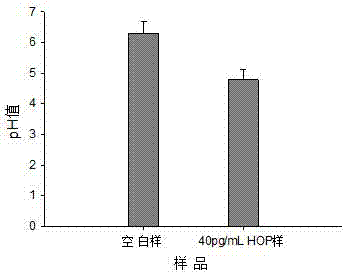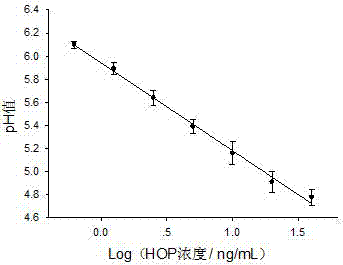ELISA (enzyme-linked immuno sorbent assay) method based on pH (potential of hydrogen) meter
An enzyme-linked immunosorbent assay technology, which is applied in the field of enzyme-linked immunosorbent assay based on pH meter, can solve the problems such as inability to use on-site analysis and instant inspection, high analysis cost, and large volume, and achieves reduction of analysis cost. Application prospect and effect of improving detection sensitivity
- Summary
- Abstract
- Description
- Claims
- Application Information
AI Technical Summary
Problems solved by technology
Method used
Image
Examples
Embodiment 1
[0019] 40 pg / mL human oncogene protein (HOP) p190 / bcr-abl antigen was detected using a pH meter-based ELISA method.
[0020] The specific implementation process is as follows:
[0021] Such as figure 1 As shown, the specific steps of this example are: Step 1, add 50 μL 0.25 mg / mL human oncogene protein (HOP) p190 / bcr-abl monoclonal antibody (10 mM carbonic acid Sodium bicarbonate-sodium carbonate buffer solution, pH 9.6), let stand overnight at 4°C in the refrigerator, discard the liquid, spin dry, fill each well with washing solution (10 mM sodium dihydrogen phosphate-dipotassium hydrogen phosphate buffer solution , pH 7.4), let it stand for 30 s and discard it, repeat this 5 times, invert the well on a flat roll paper and pat dry; step 2, add 50 μL 10 mg / mL bovine serum white to a single enzyme-labeled well Protein (BSA) (prepared in 10 mM sodium bicarbonate-sodium carbonate buffer solution, pH 9.6), let stand at room temperature for 5 h, discard the liquid, shake dry, the...
Embodiment 2
[0024] The human oncogene protein (HOP) p190 / bcr-abl antigen was detected at concentrations ranging from 0.62 to 40 pg / mL using a pH meter-based ELISA method.
[0025] The specific implementation process is as follows:
[0026] Such as figure 1As shown, the specific steps of this example are: Step 1, add 50 μL 0.25 mg / mL human oncogene protein (HOP) p190 / bcr-abl monoclonal antibody (10 mM carbonic acid Sodium bicarbonate-sodium carbonate buffer solution, pH 9.6), let stand overnight at 4°C in the refrigerator, discard the liquid, spin dry, fill each well with washing solution (10 mM sodium dihydrogen phosphate-dipotassium hydrogen phosphate buffer solution , pH 7.4), let it stand for 30 s and discard it, repeat this 5 times, invert the well on a flat roll paper and pat dry; step 2, add 50 μL 10 mg / mL bovine serum white to a single enzyme-labeled well Protein (BSA) (prepared in 10 mM sodium bicarbonate-sodium carbonate buffer solution, pH 9.6), let stand at room temperature f...
PUM
 Login to View More
Login to View More Abstract
Description
Claims
Application Information
 Login to View More
Login to View More - Generate Ideas
- Intellectual Property
- Life Sciences
- Materials
- Tech Scout
- Unparalleled Data Quality
- Higher Quality Content
- 60% Fewer Hallucinations
Browse by: Latest US Patents, China's latest patents, Technical Efficacy Thesaurus, Application Domain, Technology Topic, Popular Technical Reports.
© 2025 PatSnap. All rights reserved.Legal|Privacy policy|Modern Slavery Act Transparency Statement|Sitemap|About US| Contact US: help@patsnap.com



